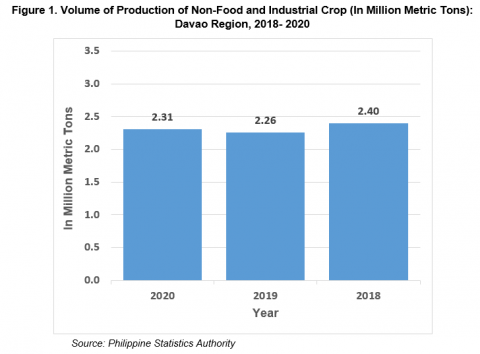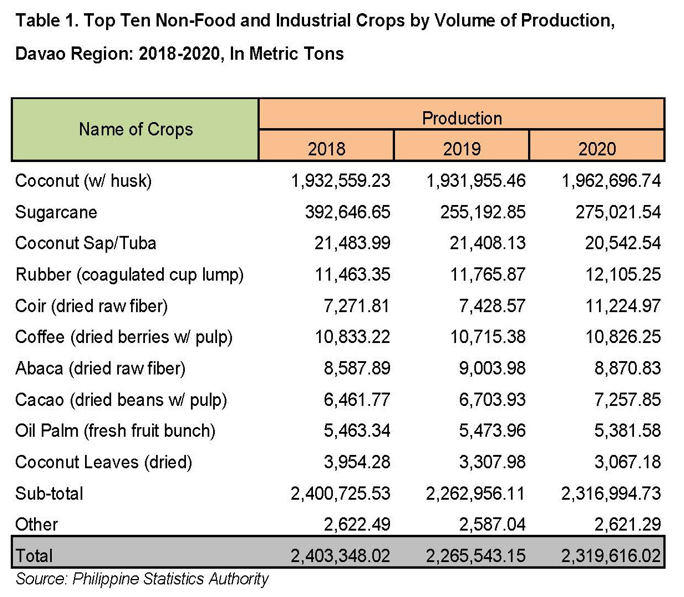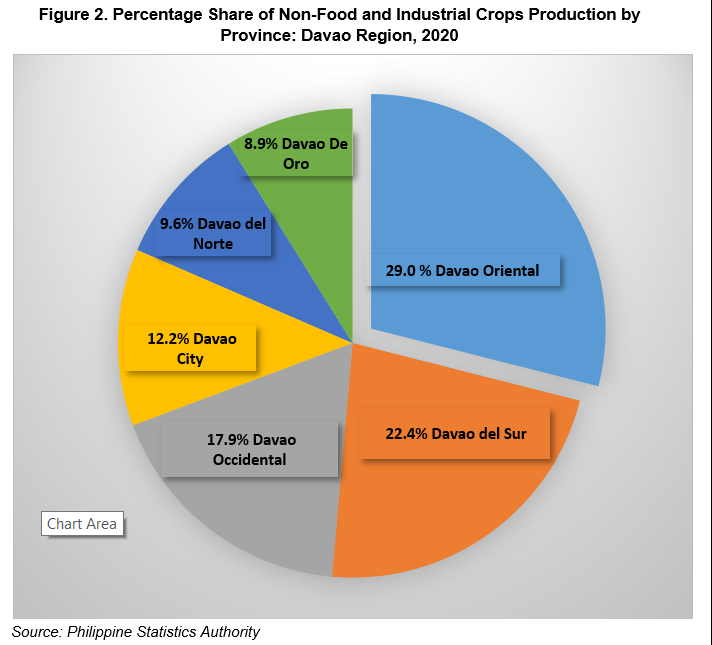Release Date :
Reference Number :
2021-026
 Non-Food and Industrial Crops production grows by 2.4 percent
Non-Food and Industrial Crops production grows by 2.4 percentNon-Food and Industrial Crops production in the region registered 2,319,616.02 Metric Tons (MT) in 2020. It grew by 2.4 percent from 2,265,543.15 MT in 2019. The growth was mainly attributed to the production increase of coconut (with husk) by 30,741.28 MT and sugarcane by 19,828.69 MT or 1.6 percent and 7.8 percent, respectively from 2019 to 2020. The total increase in 2020 was a turnaround from a decline of negative 5.7 percent between 2018 and 2019.
Top 10 Non-Food and Industrial Crops by Volume of Production
The top 10 Non-Food and Industrial Crops in 2020 accounted for 99.9 percent of the total production in the region while the rest merely contributed 0.1 percent.
• Coconut with husk accounted for 84.6 percent of the total production in 2020 at 1,962,696.74 MT. Its production contracted at negative 0.03 percent in 2019, however, gained by 1.6 percent in 2020.
• Sugarcane ranked second contributed 11.9 percent in 2020 at 275,021.54 MT. Its production substantially plunged by negative 35.0 percent in 2019 but notably improved by 7.7 percent in 2020.
• At third, coconut sap or tuba yielded 20,542.54 MT in 2020. It decelerated by negative 0.4 in 2019 and continued to slow down in 2020 by negative 4.0.
• In 2020, rubber (coagulated cup lump) extracted 12,105.25 MT. It gradually expanded in 2019 and 2020 by 2.6 percent and 2.9 percent, respectively.
• Coco coir (dried raw fiber) processed 11,224.97 MT in 2020. It remarkably enhanced by more than half or by 51.1 percent from 7,428.57 MT in 2019.
• Coffee produced 10,826.25 MT in 2020, downed by negative 1.1 percent in 2019 but gained by 1.0 percent in 2020.

Non-Food and Industrial Crops Production by Province
Davao Oriental recorded the biggest percentage share of Non-Food and Industrial Crops production in 2020 with 29.0 percent or 671,552.63 MT.
• Davao del Sur shared 22.4 percent production among the provinces/city in the region, estimated at 520,701.08 MT.
• Followed by Davao Occidental and Davao City with 17.9 percent and 12.2 percent share or yielded 415,026.27 MT and 283,219.95 MT, respectively in 2020.
• The least two provinces by percentage share in 2020 were Davao del Norte and Davao de Oro with a contribution of 9.6 percent or 223,732.76 MT and 8.9 percent or 205,383.32 MT, accordingly.

TECHNICAL NOTES
The data from this Special Release was based on the Crops Production Survey (CrPS). It is a quarterly survey which aims to generate basic production statistics for crops other than palay and corn at the national and sub-national levels. It covers more than 280 crops sub-classified under three commodity groupings, namely: 1) Non-Food and Industrial Crops, 2) Fruit Crops, and 3) Vegetables and Rootcrops. The commodity coverage by province differs and depends on what each province produces.
Crop Production is the quantity produced and actually harvested for a particular crop during the reference period. It includes those measured but damaged, stolen, given away, consumed, given as harvesters’ and threshers’ shares, reserved etc. Excluded are those produced but not harvested for whatever reasons such as due to low price, lack of demand and force majeure or fortuitous events, etc.
APPROVED FOR RELEASE:
RUBEN D. ABARO, JR., CESE
Regional Director
